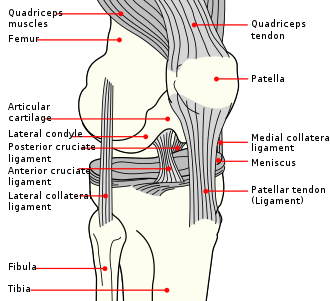Tibia
The tibia, frequently referred to as the shin bone, stands as one of the two prominent long bones found in the lower leg. It holds the distinction of being the thicker and medial (situated closer to the center of the body) of the two bones, with the other being the fibula. Functionally, the tibia plays an integral role in weight-bearing and forming the structure of the knee and ankle joints.



Anatomy and Features[edit]
The tibia extends from the knee to the ankle and exhibits a variety of anatomical landmarks:
- Proximal End: This is the top end of the tibia, which forms the larger part of the knee joint. Notable features include:
- Medial and lateral condyles: These rounded structures articulate with the femur to form the knee joint.
- Tibial tuberosity: This is a pronounced bony prominence where the patellar ligament attaches.
Shaft: The elongated, central portion of the bone. It's triangular in cross-section and possesses:
- Anterior border: The most prominent ridge which is palpable as the shin.
- Medial surface: This faces towards the inside of the leg.
- Lateral surface: This is positioned between the anterior border and the fibula.
- Distal End: This is the lower end of the tibia which contributes to the ankle joint. It has an inward facing prominence called the medial malleolus, which is palpable on the inner aspect of the ankle.
Function[edit]
The tibia holds critical biomechanical functions, including:
- Support and Mobility: As one of the primary weight-bearing bones of the body, the tibia upholds the weight of the individual and transfers it from the knee to the ankle, ensuring mobility and stability.
- Muscle Attachment: Several muscles of the lower leg, such as the calf muscles, attach to the tibia. This gives it a vital role in movements like flexion and extension of the foot.
- Protection: The anterior border of the tibia, being close to the skin surface, offers protection to the vascular and nervous structures in the lower leg.
Clinical Significance[edit]
The tibia is prone to certain injuries and conditions:
- Fractures: Tibial fractures are common, especially in athletes and individuals involved in high-impact activities. These can range from hairline fractures to complex open fractures.
- Shin splints: Medically known as medial tibial stress syndrome, this condition is characterized by pain along the shin due to overuse, often seen in runners.
- Osgood-Schlatter disease: A condition often seen in growing adolescents where there's inflammation of the tibial tuberosity.
Additional images[edit]
-
Right knee-joint. Anterior view.
-
Left talocrural joint
-
Coronal section through right talocrural and talocalcaneal joints
-
Longitudinal section of tibia showing interior
-
Dorsum of Foot. Ankle joint. Deep dissection
-
Ankle joint. Deep dissection. Anterior view
-
Bones of the right leg. Anterior surface
-
Dorsum of Foot. Ankle joint. Deep dissection.
See also[edit]
- Shin splints
- Squatting facets
- Fibula
- Femur
- Ankle joint
- Knee joint
- Bone fractures
- Musculoskeletal system
| Bones of the human leg | ||||||||||||||||||||||||||
|---|---|---|---|---|---|---|---|---|---|---|---|---|---|---|---|---|---|---|---|---|---|---|---|---|---|---|
|
Ad. Transform your life with W8MD's Budget GLP-1 injections from $75


W8MD offers a medical weight loss program to lose weight in Philadelphia. Our physician-supervised medical weight loss provides:
- Weight loss injections in NYC (generic and brand names):
- Zepbound / Mounjaro, Wegovy / Ozempic, Saxenda
- Most insurances accepted or discounted self-pay rates. We will obtain insurance prior authorizations if needed.
- Generic GLP1 weight loss injections from $75 for the starting dose.
- Also offer prescription weight loss medications including Phentermine, Qsymia, Diethylpropion, Contrave etc.
NYC weight loss doctor appointmentsNYC weight loss doctor appointments
Start your NYC weight loss journey today at our NYC medical weight loss and Philadelphia medical weight loss clinics.
- Call 718-946-5500 to lose weight in NYC or for medical weight loss in Philadelphia 215-676-2334.
- Tags:NYC medical weight loss, Philadelphia lose weight Zepbound NYC, Budget GLP1 weight loss injections, Wegovy Philadelphia, Wegovy NYC, Philadelphia medical weight loss, Brookly weight loss and Wegovy NYC
|
WikiMD's Wellness Encyclopedia |
| Let Food Be Thy Medicine Medicine Thy Food - Hippocrates |
Medical Disclaimer: WikiMD is not a substitute for professional medical advice. The information on WikiMD is provided as an information resource only, may be incorrect, outdated or misleading, and is not to be used or relied on for any diagnostic or treatment purposes. Please consult your health care provider before making any healthcare decisions or for guidance about a specific medical condition. WikiMD expressly disclaims responsibility, and shall have no liability, for any damages, loss, injury, or liability whatsoever suffered as a result of your reliance on the information contained in this site. By visiting this site you agree to the foregoing terms and conditions, which may from time to time be changed or supplemented by WikiMD. If you do not agree to the foregoing terms and conditions, you should not enter or use this site. See full disclaimer.
Credits:Most images are courtesy of Wikimedia commons, and templates, categories Wikipedia, licensed under CC BY SA or similar.
Translate this page: - East Asian
中文,
日本,
한국어,
South Asian
हिन्दी,
தமிழ்,
తెలుగు,
Urdu,
ಕನ್ನಡ,
Southeast Asian
Indonesian,
Vietnamese,
Thai,
မြန်မာဘာသာ,
বাংলা
European
español,
Deutsch,
français,
Greek,
português do Brasil,
polski,
română,
русский,
Nederlands,
norsk,
svenska,
suomi,
Italian
Middle Eastern & African
عربى,
Turkish,
Persian,
Hebrew,
Afrikaans,
isiZulu,
Kiswahili,
Other
Bulgarian,
Hungarian,
Czech,
Swedish,
മലയാളം,
मराठी,
ਪੰਜਾਬੀ,
ગુજરાતી,
Portuguese,
Ukrainian







